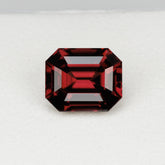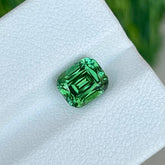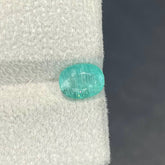This specimen features an aggregate of thick book Muscovite mica sheets inter grown with tourmaline crystals, sourced from Pakistan. The Muscovite mica is characterized by its layered structure, appearing as stacked sheets that are slightly flexible and translucent, with a pearly to vitreous luster. These sheets have a silvery-gray to light brown hue, and their thickness and density create a robust and substantial appearance, often referred to as "book mica" due to their resemblance to the pages of a book. Interspersed among the mica sheets are elongated, prismatic tourmaline crystals, which add a striking contrast with their deep black to dark green coloration. The tourmaline exhibits a vitreous luster and may display striations along its length, enhancing its visual appeal.
Product Information:
| Specimen |
Muscovite Mica crystals with Tourmaline
|
| Weight |
209 grams |
| Dimensions |
H: 7.8 x W: 6.2 x D: 4 cm |
| Origin |
Skardu District, Gilgit Baltistan, Pakistan
|
| Treatment |
None |
Muscovite Description:
Muscovite is the most common mineral in the mica's own family. It is an essential rock-forming mineral found in igneous, metamorphic, and sedimentary rocks. Like different micas, it easily cleaves into skinny transparent sheets. Muscovite sheets have a pearly to vitreous luster on their floor. If they're held as much as the light, they're transparent and almost colorless, but most have a mild brown, yellow, green, or rose-color tint.
The capacity of muscovite to cut into thin transparent sheets - occasionally up to several feet across - gave it an early use as window panes. In the 1700s it was mined for this use from pegmatites in the location around Moscow, Russia. Those panes were referred to as "Muscovy glass" and that term is an idea that inspired the mineral name "muscovite."
Muscovite Associations:
|
Chakras
|
Heart Chakra,
|
|
Luster
|
Vitreous, Silky, Pearly
|
|
Zodiac
|
Leo
|
|
Tenacity
|
Elastic
|
|
Hardness
|
2.5 to 3
|
|
Color
|
White, Grey, Silvery
|
Healing Properties of Muscovite:
- Muscovite is superb for inspiring reflection and self-evaluation.
- Muscovite permits you to reflect on the past and the self objectively and without fear.
- Muscovite may additionally help in auric cleaning and unblocking the psychic channels. Muscovite encourages clarity in visions and self-reflection.
- Muscovite may be used during times of cleansing or fasting to help reduce hunger pangs, provide strength, relieve dehydration, and give a general increase.
- Muscovite may help sufferers of insomnia, nighttime sweats, nightmares, stressed leg syndrome, and sleep apnea.
Muscovite Mica and Tourmaline
Muscovite Mica and Tourmaline, individually captivating minerals, combine to form a stunning geological wonder found in Pakistan. Muscovite Mica, known for its reflective and layered structure, intertwines with the vibrant hues of Tourmaline to create a visually mesmerizing composition.
Geological Origins in Pakistan
These lustrous compact crystals are predominantly unearthed in the picturesque mountainous regions of Pakistan. The specific geological conditions and metamorphic processes in these areas foster the formation of these unique mineral amalgamations.
Characteristics of Lustrous Muscovite Mica Compact Crystals with Tourmaline
The crystals exhibit a remarkable luster and distinct layered structure. Muscovite Mica's reflective nature, combined with the striking colors of Tourmaline, creates a visual spectacle. The crystals often showcase a blend of earthy tones or vivid hues, depending on the minerals' composition and geological influences.
Significance in the Mineralogical World
The fusion of Muscovite Mica with Tourmaline in compact crystals from Pakistan holds significant importance in the realm of mineralogy. These specimens represent a convergence of geological forces, showcasing the interplay of elements and the fascinating results of this natural alchemy.
Uses and Applications
Beyond their aesthetic allure, these crystals have practical applications. Muscovite Mica is renowned for its electrical insulating properties, while Tourmaline finds uses in technology due to its piezoelectric and pyroelectric qualities. Additionally, these specimens are cherished by collectors and enthusiasts for their rarity and beauty.
Preservation and Collection of these Specimens
Preserving the integrity of these delicate crystals is vital. Proper storage and handling techniques are crucial to maintain their aesthetics and geological significance. Collectors and museums often use specific methods to safeguard and display these treasures for long-term appreciation.
Appreciating the Beauty and Rarity
The lustrous Muscovite Mica Compact Crystals interwoven with Tourmaline from Pakistan are not only geological marvels but also aesthetic treasures. Their rarity, combined with their unique formation, serves as a testament to the diverse and wondrous capabilities of the Earth's geological processes.
FAQs:
1. What causes the vibrant colors in Tourmaline found in these crystals?
The diverse color spectrum in Tourmaline is a result of trace mineral elements present during its formation. These elements cause color variations, resulting in the mesmerizing hues seen in these crystals.
2. Are these crystals primarily found in a specific region of Pakistan?
Yes, these specific lustrous compact crystals predominantly originate from the mountainous regions of Pakistan, particularly in areas known for their geological richness.
3. What makes Muscovite Mica and Tourmaline a unique combination in these specimens?
Muscovite Mica's reflective layers, coupled with Tourmaline's vibrant colors, create a visually captivating and distinct composition. This amalgamation showcases the beauty of these minerals in a way rarely found elsewhere in nature.
4. How are these crystals collected and preserved for display or research purposes?
Collection and preservation involve delicate extraction methods and precise storage conditions to prevent damage. Collectors often use specialized tools, and museums employ controlled environments to display and conserve these specimens for research and admiration.
5. Are there any scientific studies conducted on these crystals' geological formations in Pakistan?
Yes, various scientific studies have explored the geological processes responsible for the formation of these crystals in Pakistan. Researchers continue to investigate the specific conditions that lead to the unique amalgamation of Muscovite Mica and Tourmaline.








